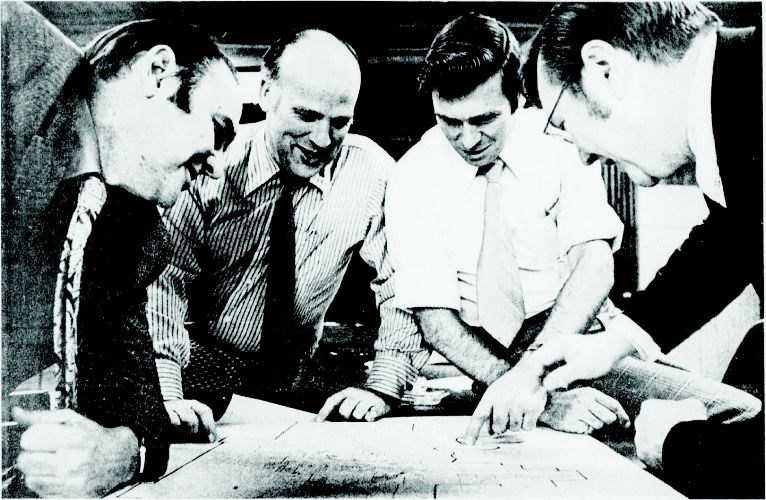Editor's note: Forty years ago, the City of Prince George expanded its boundaries through amalgamation. This is the first in a multi-part series exploring how that act changed Prince George beyond the redrawing of the map.
"The year 1974 could be an epic year for the city," former mayor Harold Moffat told city council on Jan. 7, 1974.
"Epic in the sense that 1974 could be the last year of boundary expansion in the history of the city of Prince George."
Moffat's opening address, according to meeting minutes dug up by local historian Valerie Giles for her 2007 book, Harold Moffat and the Northern Hardware: Prince George Icons, would prove to be a self-fulfilling prophecy.
The year was amalgamation heavy as Moffat and other local leaders made the rounds stating the case for amalgamation in the months leading to an ultimately successful Nov. 2, 1974 vote.
And with the flip of a calendar page to 1975, Prince George officially stretched out to encompass roughly 345 square kilometres and an estimated 60,000 residents. Where the city boundaries once ended in the Bowl, they now included the formerly disparate Hart, North Nechako, College Heights, Peden Hill, Beaverly, South Fort George and Blackburn communities.
Prince George was one of a handful of municipalities where the provincial government decided it had to expand its boundaries for its own good.
A B.C. Ministry of Municipal Affairs guide published in 2000 describes what happened in Prince George, along with Kamloops, Kelowna and Nanaimo (all changed between 1972 and 1975), as "multi-municipality restructuring."
The cities were the target of a new, more-aggressive approach the B.C. government tried out in the early- to mid-1970s. While Kamloops and Kelowna were forced to amalgamate through legislation, Nanaimo and Prince George were "restructured through provincial mandates," the guide says, but adds that local politicians supported the action and that it was ultimately ratified by the electorate.
After Kamloops and Kelowna had the hammer dropped on them in 1973, local politicians watched in anticipation for the province's attention to be turned on Prince George.
Though the New Democrat Municipal Affairs Minister James Lorimer said it wouldn't happen without the residents' support, the prevailing belief among those in power at the time was that it was going to happen regardless.
Mayor Moffat wanted to head it off at the pass and, in order to not be caught unawares, formed a committee in early 1973 to study the creation of a greater Prince George.
When it came down to it, amalgamation was sold to the residents of what would become the current-day Prince George as a necessity.
Unlike in the Bowl, where growth had stagnated after a pulp mill-related boom in the 1960s, things had a more wild west feel (when it came to planning) in the outlying areas.
There, they were experiencing water shortages and unregulated expansion since decisions in unincorporated areas were made in Victoria.
Outside of the city's or regional district's purview, the running of individual communities' water and sewer systems fell to local improvement district trustees.
In late October 1974, just a handful of days before voters went to the polls, Fort George NDP MLA Alf Nunweiler told The Citizen that, though they weren't being forced into it, amalgamation was the best bet for everyone.
"Nunweiler says greater Prince George is developing too fast to be without local government. The problems which have just begun to surface are bound to get worse and neither the provincial government nor the Fraser-Fort George Regional District is equipped to solve them," reported Tom Nixon in the Oct. 30, 1974 paper.
A few days earlier, the chair of the College Heights Improvement District Maurice Cocking laid out a grim future for his area without amalgamation - one where his 2,000-person community couldn't afford its own fire department.
"They don't have the slightest idea how much things cost," he told The Citizen. "One of these days the developer (Prince George College Lands Ltd.) is going to turn over all the administrative work to them and then they'll find out."
In what Nixon described as an "uncharacteristic show of emotion," Moffat pled the city's case for Nechako area residents during an October public meeting.
"It disturbs me that there doesn't seem to be a trust or that you won't join in planning the destiny of the area," Moffat said. "This is the first and possibly last time Prince George and the area around it will have a chance to grow and plan together."
But Moffat's words went unheeded. The 1974 referendum passed with a 55.3 per cent favourable vote, but those 'yes' votes came primarily from within the existing city.
Prince George voters approved the new borders by 77.7 per cent and of those outside the existing boundaries, only College Heights and Peden Hill voters delivered a majority in favour of joining Prince George.
Next time....
Throughout the study and consultation process, amalgamation proponents were met with concerns over higher tax rates and forced urbanization. The province was promising funds to help alleviate some of those concerns. Where did that money go?


